- City Fajr Shuruq Duhr Asr Magrib Isha
- Dubai 05:18 06:35 12:07 15:09 17:33 18:50
The toll from a dam collapse at a mine in southeast Brazil's Minas Gerais state has risen to 157 deaths after nearly two weeks of searches, with 182 missing, authorities said Thurday.
Those listed as missing are presumed dead, but not yet located under the layers of muddy mining waste released when the tailings dam broke apart in the town of Brumadinho on January 25.
In recent days, rescue teams have battled rains which limited their ability to fly helicopters over the area.
Virtually all the dead and missing were workers at the iron ore mine, buried under an avalanche of sludgy mining waste when the dam collapsed above the facility's cafeteria and main administrative area.
Death toll in Brazil dam collapse rises to 110
A Brazilian official says the number of confirmed deaths from last Friday’s collapse of a dam at an iron ore mine has risen to 110 from 99.
Lt. Flavio Godinho of the Minas Gerais state civil defense agency said Thursday that 238 people are listed as missing.
The Minas Gerais Fire Department has said it does not want to stop the search for victims yet even though no one has been found alive since Saturday.
Searchers probe deep mud from Brazil dam breach; 65 dead
Brazilian firefighters workers poked sticks into treacherous mud Monday looking for bodies as pressure mounted on the mining company responsible for a dam that burst and spilled a flood of iron ore waste.
By late in the day, the death toll rose to 65, with 279 people still missing, said Lt. Col. Flavio Godinho of the civil defense department in the southeastern state of Minas Gerais.
In a sign of the risks posed by the deep mud, Col. Alexandre Ferreira, a doctor with the military police of Minas Gerais, advised rescue crews, volunteers and journalists to take antibiotics to prevent cholera, the bacterial infection leptospirosis and other diseases.

Officials said the death toll was expected to grow “exponentially,” since no had been rescued alive since Saturday.
Search efforts were extremely slow because of the treacherous sea of reddish-brown mud that surged out when the mine tailings dam breached Friday afternoon. The mud was up 24 feet (8 meters) deep in some places, forcing searchers to carefully walk around the edges of the muck or slowly crawl onto it so they would not sink and drown.
Teams focused their searches Monday morning in areas where a bus was immersed and where many workers were eating lunch at the mine cafeteria when the dam ruptured.

The mine’s owner, Vale SA, is the world’s largest producer of iron ore, the raw ingredient for making steel.
The Brazilian company’s American depository shares plunged 18 percent Monday on the New York Stock Exchange.
At the scene of the disaster, helicopters looking for bodies took off and landed nonstop.

On the ground, dozens of rescuers with tracking dogs were searching for bodies through the mountains of mud. An Associated Press photographer witnessed at least 10 helicopters each carrying one body.
“The company didn’t take care of the people,” said Josefa de Santos, who has friends and neighbors among the missing.
“I heard the cries of people asking for help, everyone was running and screaming. The siren didn’t go off at all, it was horrible.”
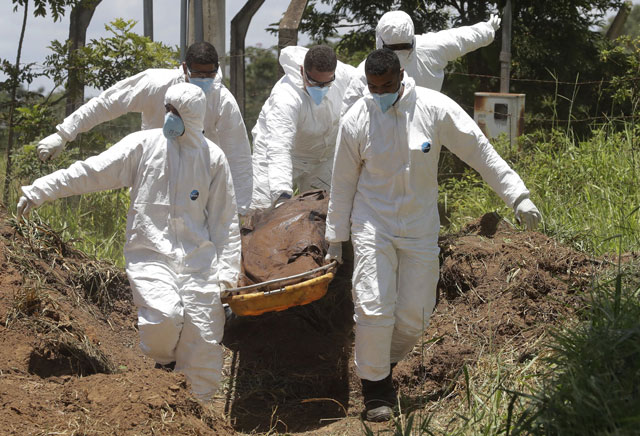
In an email, Vale told The Associated Press that the area has eight sirens, but “the speed in which the event happened made sounding an alarm impossible” when the dam burst.
Sen. Renan Calheiros called for Vale’s board of directors to step down and Attorney General Raquel Dodge told reporters that Vale executives could be held responsible.
Vice President Hamilton Mourão said a Brumadinho crisis committee established by the president was “studying” the possibility of removing Vale’s board of directors. His office later told AP that the government wouldn’t intervene, as Vale is a private company.
Over the weekend, courts froze about $3 billion from Vale assets for state emergency services and told the company to report on how it would help victims.
The carpet of mining waste also raised fears of widespread environmental contamination and degradation.
Photos: AP
Firefighters search mud after Brazil dam collapse; 58 dead
The Civil Defense office in the Brazilian state of Minas Gerais has raised the number of confirmed deaths in a dam collapse to 58.
More than 300 people are still missing after iron ore waste from a mine that flooded the southeastern city of Brumadinho on Friday.
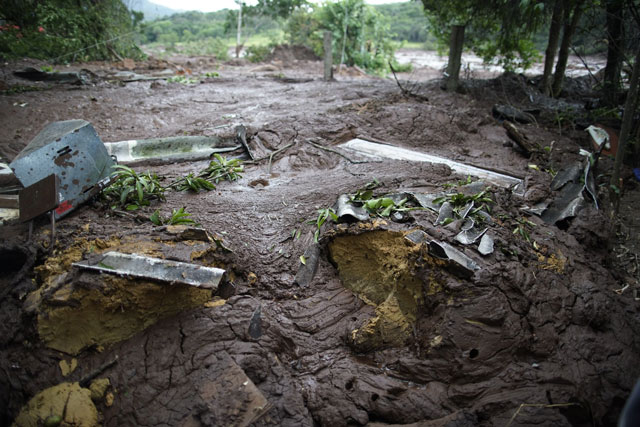
Brazilian officials resumed the search the missing Sunday after briefly suspending it amid fears that a second dam was at risk of breach.
Rescue workers say areas of water-soaked mud appear to be drying out, which could help firefighters get to areas previously unreachable.
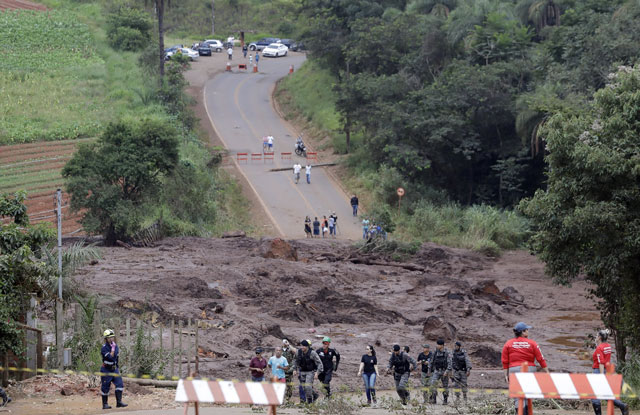
The death toll is expected to rise.
Photos: AP
40 dead, many feared buried in mud after Brazil dam collapse
The death toll from the collapse of a dam holding back mine waste in southeastern Brazil rose to 40 on Saturday as searchers flying in helicopters and rescuers laboring in deep mud uncovered more bodies.
An estimated 300 people were still missing and authorities expected the death toll to increase during a search made more challenging by intermittent rains.
Scores of families in the city desperately awaited word on their loved ones, and Romeu Zema, governor of Minas Gerais state, promised that those responsible “would be punished.”
Employees of the mining complex owned and operated by Brazilian mining company Vale were eating lunch Friday afternoon when the dam gave way, unleashing a sea of reddish-brown mud that knocked over and buried several structures of the company and surrounding areas.
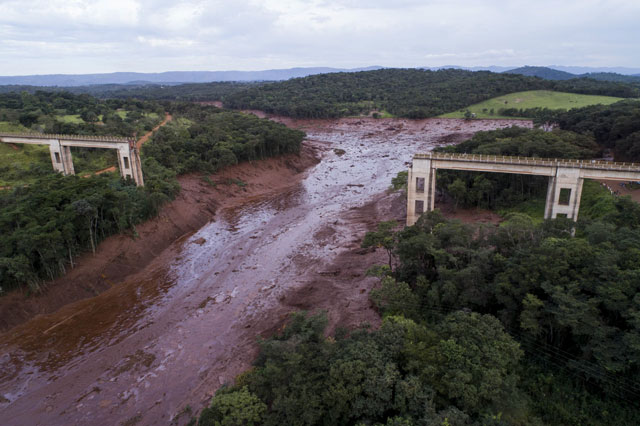
The level of devastation quickly led President Jair Bolsonaro and other officials to describe it as a “tragedy.”
The flow of waste reached the nearby community of Vila Ferteco and an occupied Vale administrative office. On Saturday, rooftops poked above an extensive field of the mud, which also cut off roads.
After the dam collapse, some were evacuated from Brumadinho. Other residents of the affected areas barely escaped with their lives.
“I saw all the mud coming down the hill, snapping the trees as it descended. It was a tremendous noise,” said a tearful Simone Pedrosa, from the neighborhood of Parque Cachoeira, about 5 miles (8 kilometers) from where the dam collapsed.
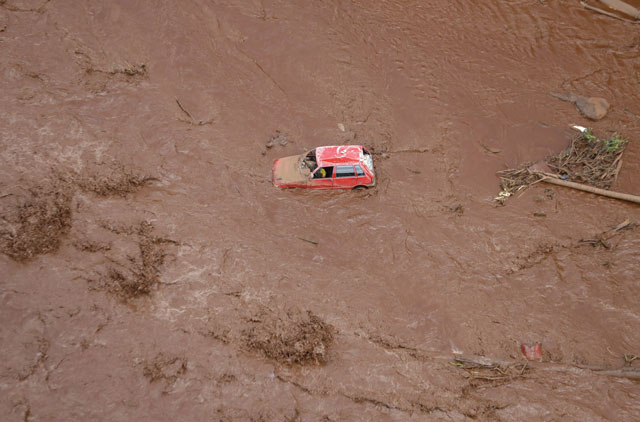
Pedrosa, 45, and her parents dashed to their car and drove to the highest point in the neighborhood.
“If we had gone down the other direction, we would have died,” Pedrosa said, adding that she had a feeling “that this was the end of my life.”
“I cannot get that noise out of my head,” she said. “It’s a trauma ... I’ll never forget.”
In addition to the 40 bodies recovered as of Saturday afternoon, 23 people were hospitalized, said authorities with the Minas Gerais fire department.
There had been some signs of hope earlier Saturday when authorities found 43 more people alive.
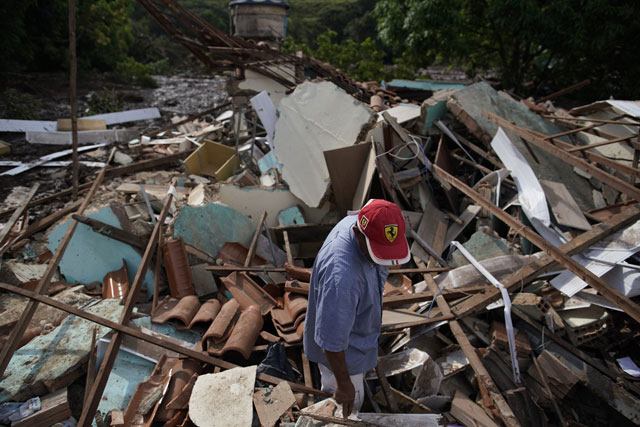
Company officials also had said that 100 workers were accounted for.
Emergency workers suspended their search shortly after nightfall.
They planned to resume at first light Sunday morning.
For many, hope was fading to anguish.
The rivers of mining waste also raised fears of widespread contamination.
According to Vale’s website, the waste, often called tailings, is composed mostly of sand and is non-toxic.
However, a U.N. report found that the waste from a similar disaster in 2015 “contained high levels of toxic heavy metals.”
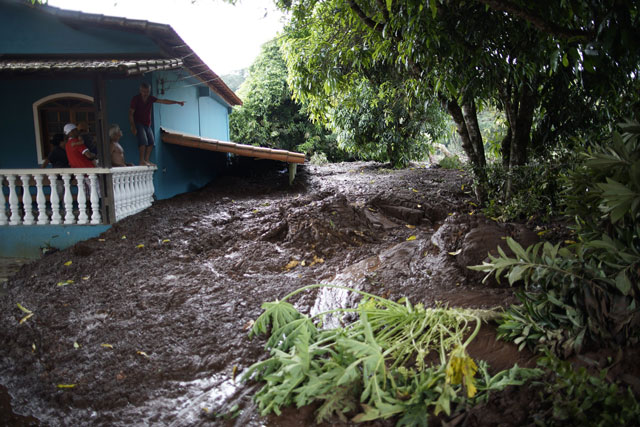
On Friday, Minas Gerais state court blocked $260 million from Vale for state emergency services and told the company to present a report about how they would help victims.
On Saturday, the state’s justice ministry ordered an additional $1.3 billion blocked.
Brazil’s Attorney General, Raquel Dodge promised to investigate, saying “someone is definitely at fault.”
Dodge noted there are 600 mines in the state of Minas Gerais alone that are classified as being at risk of rupture.
Another dam administered by Vale and Australian mining company BHP Billiton collapsed in 2015 in the city of Mariana in Minas Gerais state, resulting in 19 deaths and forcing hundreds from their homes. Considered the worst environmental disaster in Brazilian history, it left 250,000 people without drinking water and killed thousands of fish. An estimated 60 million cubic meters of waste flooded rivers and eventually flowed into the Atlantic Ocean.
Schvartsman said what happened Friday was “a human tragedy much larger than the tragedy of Mariana, but probably the environmental damage will be less.”
Sueli de Oliveira Costa, who hadn’t heard from her husband since Friday, had harsh words for the mining company.
“Vale destroyed Mariana and now they’ve destroyed Brumadinho,” she said.
Daily Folha de S.Paulo reported Saturday that the dam’s mining complex was issued an expedited license to expand in December due to “decreased risk.” Preservation groups in the area alleged that the approval was unlawful.
On Twitter, President Bolsonaro said his government would do everything it could to “prevent more tragedies” like Mariana and now Brumadinho.
The far-right leader campaigned on promises to jump-start Brazil’s economy, in part by deregulating mining and other industries.
Environmental groups and activists said the latest spill underscored a lack of regulation, and many promised to fight any further deregulation by Bolsonaro in Latin America’s largest nation.
“History repeats itself,” tweeted Marina Silva, a former environmental minister and three-time presidential candidate.
“It’s unacceptable that government and mining companies haven’t learned anything.”
But the company said in a statement Saturday afternoon that more than 200 workers were still missing, while fire officials at one point estimated the total number at close to 300.
Vale CEO Fabio Schvartsman said he did not know what caused the collapse.
About 300 employees were working when it happened.
Photos: AP
![]() Follow Emirates 24|7 on Google News.
Follow Emirates 24|7 on Google News.